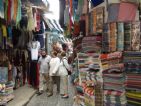
Way to the Baazar
Comparisson reports are under license of:

Lo que dice el Arxiduc:
“A part of the city’s life could already be seen on the little street leaving towards the plaza. A colourful crowd of people floated above the sun-roasted pavement: a Moor atop his horse, a poor barefoot camel driver, Arab women with their eyebrows artificially joined together and covered half in black, and Jewish women with narrow trousers reaching down to their feet.
One house follows after another, one group after another, in a row full of colour. Here is a weightless Moorish arch, as if made by a fairy, above a road, and there is a minaret rising light into the air, crowned by terraces above the buildings. At times, a window with iron bars opens onto the noisy street, illuminating some colourful domestic scene.”
( Ph. 5 Street in Tunis)
Archduke Ludwig Salvator of Austria, Tunis. Ein bild aus dem nordafrikanischen leben, Heinrich Mercy, Prague, 1870
Datos proyecto Nixe III:

Here we see another pretty street with arches. People have taken advantage of some to build additional rooms on top. We can see a lot of horseshoe arches in some homes, mosques and hammams (bathhouses).
Leaving the bazaar behind and heading towards the Kasbah on the opposite side of the city, we reach a part of Tunis that is less frequented as there aren’t any shops there. The buildings are not as well maintained here though they haven’t lost any of their old charm.
























